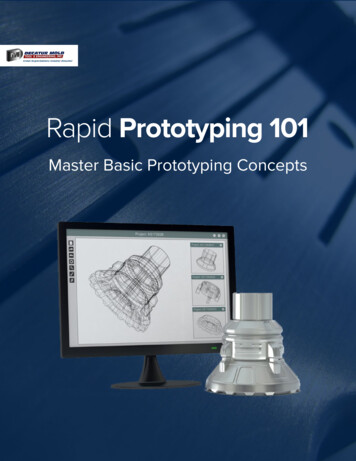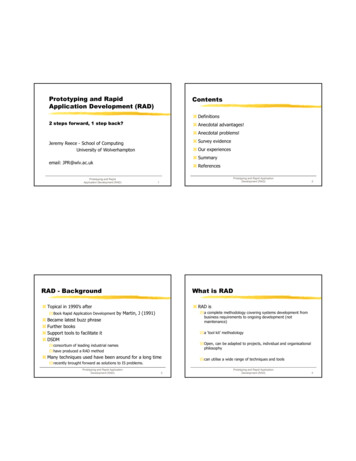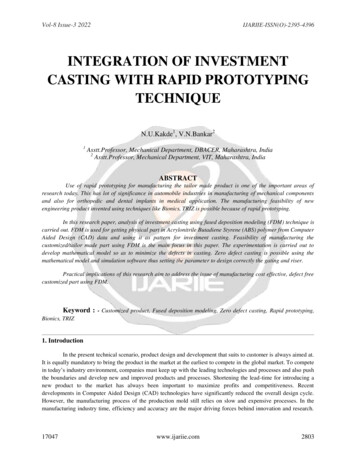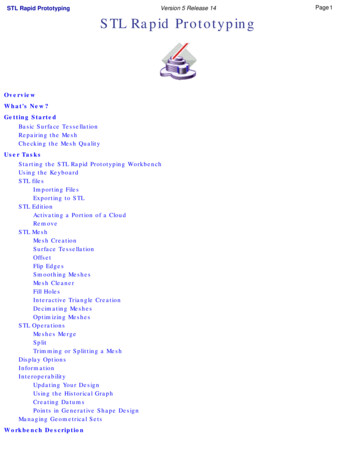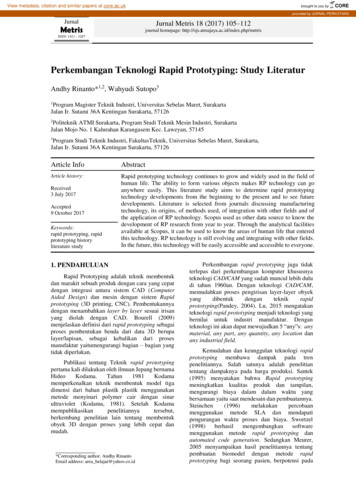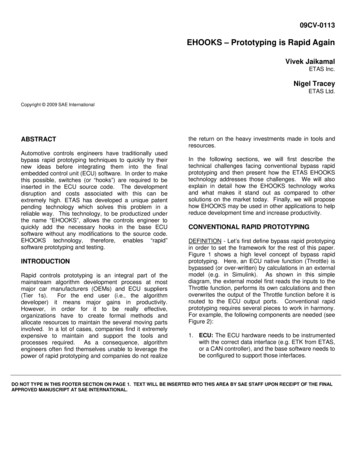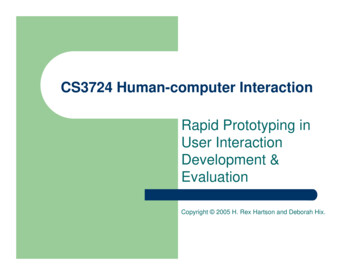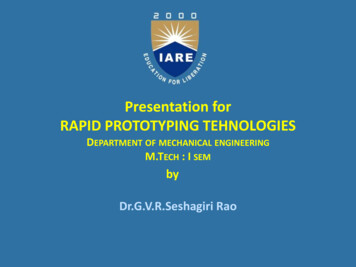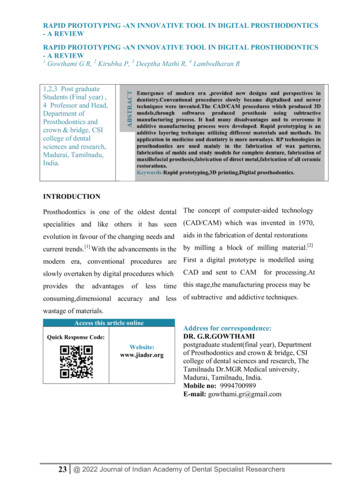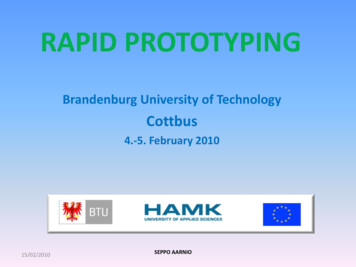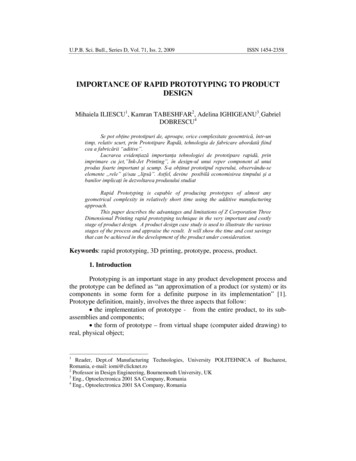
Transcription
U.P.B. Sci. Bull., Series D, Vol. 71, Iss. 2, 2009ISSN 1454-2358IMPORTANCE OF RAPID PROTOTYPING TO PRODUCTDESIGNMihaiela ILIESCU1, Kamran TABESHFAR2, Adelina IGHIGEANU3, GabrielDOBRESCU4Se pot obţine prototipuri de, aproape, orice complexitate geoemtrică, într-untimp, relativ scurt, prin Prototipare Rapdă, tehnologia de fabricare abordată fiindcea a fabricării “aditive”.Lucrarea evidenţiază importanţa tehnologiei de prototipare rapidă, prinimprimare cu jet,”Ink-Jet Printing”, în design-ul unui reper component al unuiprodus foarte important şi scump. S-a obţinut prototipul reperului, observându-seelemente „rele” şi/sau „lipsă”. Astfel, devine posibilă economisirea timpului şi abanilor implicaţi în dezvoltarea produsului studiatRapid Prototyping is capable of producing prototypes of almost anygeometrical complexity in relatively short time using the additive manufacturingapproach.This paper describes the advantages and limitations of Z Corporation ThreeDimensional Printing rapid prototyping technique in the very important and costlystage of product design. A product design case study is used to illustrate the variousstages of the process and appraise the result. It will show the time and cost savingsthat can be achieved in the development of the product under consideration.Keywords: rapid prototyping, 3D printing, prototype, process, product.1. IntroductionPrototyping is an important stage in any product development process andthe prototype can be defined as “an approximation of a product (or system) or itscomponents in some form for a definite purpose in its implementation” [1].Prototype definition, mainly, involves the three aspects that follow: the implementation of prototype - from the entire product, to its subassemblies and components; the form of prototype – from virtual shape (computer aided drawing) toreal, physical object;1Reader, Dept.of Manufacturing Technologies, University POLITEHNICA of Bucharest,Romania, e-mail: iomi@clicknet.ro2Professor in Design Engineering, Bournemouth University, UK3Eng., Optoelectronica 2001 SA Company, Romania4Eng., Optoelectronica 2001 SA Company, Romania
118Mihaela Iliescu, Kamran Tabeshfar, Adelina Ighigeanu, Gabriel Dobrescu the degree of approximation of a prototype – from a rough representationto an accurate replicate of the part.In Rapid Prototyping (RP) virtual designs are “taken” from computeraided design (CAD) or animation modeling software and transformed into thin,virtual, horizontal cross-sections. Each cross-section is created in physical space,one after the next until the model is finished, so it is a WYSIWYG (What YouSee Is What You Get) process where the virtual model and the physical modelcorrespond almost identically. An important difference between this andconventional machining is that the prototype is obtained by layer to layer addition,as opposed to removing material from a “block”.In Rapid Prototyping, objects can be formed with any geometriccomplexity or intricacy without the need for elaborate machine setup or finalassembly. They can be made from multi materials such as composites, andmaterials can be varied in a controlled fashion at any location in the object. So,the construction of complex parts can be reduced to a manageable,straightforward, and relatively fast process [5].There are three main Rapid Prototyping systems, depending on initial theform of materials involved: liquid-based RP systems – the initial form of material is in liquid stateand, by a curing process, the liquid is converted into solid state; the systemincludes: 3D Systems’ Stereolithography (SLA), Light Sculpting, Rapid Freezeand Two Laser Beams; solid-based RP systems – the initial form of material is in solid state,except for powders (wire, roll, laminates, pellets); this system includes: Stratasys‘Fused Deposition Modeling (FDM), 3D Systems’, Multi-Jet Modeling System(MJM) and Pares lamination Technology (PLT); powder-based RP systems – the initial form of material is powder; thesystem includes: 3D Systems’ Selective Laser Sintering (SLA), Precision OpticalManufacturing’s Direct Metal Deposition (DMD) and Z Corporation’s ThreeDimensional Printing (3DP).A commonly used Rapid Prototyping technique is that of Z Corporation. Itis based on three-dimensional printing, which involves shooting droplets of binderon a powder layer to selectively bind powder together for each layer [6].Therefore, relatively quick and not too expensive models can be obtained forchecking the product design process or for testing products’ characteristics, byprototype testing. Usually, the model’s surface finish is not very good but, afterimpregnation, several machining procedures can be applied to improve the surfaceor, even to obtain surface configuration, such as threads, that could not be safelyobtained by Rapid Prototyping [3].A schematic representation of ink jet 3D printing process is represented infigure 1 [2].
Importance of rapid prototyping in product design119Fig. 1 Schematic representation of 3D printing process [2]2. Prototyped partDocument security, nowadays, is a very important international issue; thisincludes combating fraud in official documents such as bank notes and identitypapers and there has been much effort in developing effective anti-fraud tools.One very modern device is a “video-mouse” – see figure 2, used inidentification of fraud for documents such as visas, bank notes, identity cards,passports, holograms and stamps. It works in visible, ultraviolet and infraredradiation fields, and allows direct checking and processing of video signals andimages, by USB port transfer.The video-mouse can print the security elements that are visible or hiddeninto high security documents, such as: ultraviolet sensitivity fibers, micro-texts,wire marks, hidden images, optical-variable printing, invisible ink, infrared fields,and mechanical manipulation. It plots out ink pigments variation, by adsorption,transmission and reflection in different spectrum lengths, from 375 nm to 950 nm.The above device is a modern and very efficient one, enabling the officialsto obtain as much reliable important information as they would using a complexinvestigation system.
120Mihaela Iliescu, Kamran Tabeshfar, Adelina Ighigeanu, Gabriel DobrescuFig. 2 Video-mouse assembly drawingThe part whose prototyping benefits are going to be shown in this paper isthe upper case of an anti-fraud device – see figure 3. Other components of theassembly were also prototyped (e.g. the lower case) and they were all finallyjoined/fitted together, in order to have an “image” of the whole device.Fig. 3 Computer aided design of the part (upper case) to be prototyped
Importance of rapid prototyping in product design1213. Rapid prototyping by 3D printingRapid prototyping by three dimensional printing, involved a technologicalsystem based on:- ZPrinter 310 Plus printing machine (Z Corporation) [7];- zp 131 powder (high performance composites for tough parts and verygood resolution); zb60 binder solution and z-max high strength epoxy [7] –representing materials used for rapid prototyping;- compressed air cleaning enclosure;- electric oven.Three dimensional printing is carried out using the “steps” outlined below.a. Computer aided designing of the part to be prototyped – see figure 3.b. “Recognizing” the design by printing machine software, ZPrint andmodels positioning within machine’s modeling enceinte – see figure 4.Fig. 4 Positioning parts to be prototypedc. Automatic calculation of the required volume / mass amount of binder /powder (estimated binder usage: 37,0 ml; total volume of parts: 78.78 cm3) – seefigure 5.d. Setting machining parameters, such as 0.0889 mm layer thickness, andthe automatic calculation of layers and prototyping time (number of layers: 484;estimated build time: 1 hour and 26 min) – see figure 5.e. Three dimensional printing process – i.e., successively layer by layeradditive fabrication, obtaining the prototype.
122Mihaela Iliescu, Kamran Tabeshfar, Adelina Ighigeanu, Gabriel DobrescuFig. 5 Automatic calculi of printing process characteristicsf. Once the process is over and the powder prototypes harden (theestimated time for it is given on the computer screen after the models constructionis carried out), the prototype is carefully extracted out of ZPrinter modelingenceinte.g. The produced model is ‘cleaned’ from the support structure (not bondedto the main model), and put into a special vacuum enclosure and the edgesmanually trimmed, if necessary.h. The prototype is dried in an electric oven and then impregnated by amixture of special binder and high strength epoxy. Thus, a hard and ready to usepart is obtained.4. Importance of rapid prototyping in product design case studyThe product under consideration, the video-mouse, will be manufacturedin mass production; the process of prototyping its important components, possiblemistakes or “misfits” in parts design can be avoided or corrected.The problems discussed here will all relate to the case study underconsideration.An important mechanical property of the model produced is its tensilestrength value. The mathematical relation for it is given by [2]:σ Kσ 0 (1 ε )m Kσ 0 (Δ )m(1)where: σ is the tensile strength and σ0 - wrought strength of the same alloy [MPa]K – geometric and process dependent constant;m – constant;ε - relative porosity;Δ - relative density (Δ 1 ε )
Importance of rapid prototyping in product design123When considering the characteristics of the powder (zp 131) and thebinder used, applying equation (1), should give a result similar to that of the massproduced manufactured component (injection molding of polymeric material).Accordingly, σ (87.68 – 101.27) [MPa].Thus, it is assumed that any problem in the prototype “behavior” is similarto that of the real, injected molded part obtained. Thus, observing the failures,features of the prototype will inform on the changes needed in the part design.Some important features that were carefully studied (see figure 6) are: failures and cracks of the corners, because of too small value of thecorner radius; the cylindrical parts that had to be drilled and threaded (by furtherdrilling and threading) broke off during machining, as their wall thickness had notenough resistance; one of the positioning “shafts”, also broke off because its diameter wastoo small and its position did not fit well with the corresponding positioning of the“holes” of the mating component.broken off whendrilling and threadingbroken off when tryingto fit with matingcomponentcorner cracksFig. 6 Severe problems pointed out by prototypingSo, appropriate changes in part design were carried out and theprototyping process was performed again. The new model obtained did not haveany of the previous problems– see figure 7.Fig. 7. New part rapid prototype
124Mihaela Iliescu, Kamran Tabeshfar, Adelina Ighigeanu, Gabriel Dobrescu5. Conclusions In rapid prototyping, using additive fabrication, the physical, real,model and the virtual components all have similar features. A commonly usedRapid Prototyping technique is that of Z Corporation and is based on threedimensional printing. The paper describes rapid prototyping benefits in designing a criticalcomponent, “upper case”, of a “video-mouse” security device. As a result of 3D printing technology, it was possible to discover errorsor “misfits” in the design of the part and, thus achieve time and cost savings. Once the required corrections were carried out no more problems wereencountered in the subsequent prototype, and the further steps of the component’smass production process could be carried out. For the studied “upper case” part,injection molding, the risk of component failure was reduced. Further research should be developed for all of the product’s componentparts, using this or other different rapid prototyping techniques. Also, possibleinfluencing factors for the prototype’s mechanical characteristics and geometricfeatures may be studied.REFERENCES[1]. C.K. Chua, K.F. Leong, C.CL im, “Rapid Prototyping, Principles and Applications”, WorldScientific Publishing Co. Ltd., 2005[2]. N. Hopkinson, R.J.M. Hague, P.M. Dickens, “Rapid Manufacturing, an Industrial Revolutionfor the Digital Age”, John Wiley & Sons Ltd., 2006[3]. Mihaela liescu, E. Nuţu, L. Georgescu, “Finite Element Method Simulation and RapidPrototyping”, 8th WSEAS International Conference on ELECTRIC POWER SYSTEMS,HIGH VOLTAGES, ELECTRIC MACHINES (POWER '08), pag. 257-262, ISBN 978-960474-026-0, ISSN 1790-5117, Venice, Italy, November 21-23, 2008 (ISI)[4]. Rapid Prototyping, Available from: http://en.wikipedia.org/wiki/Rapid prototyping,Accessed: 2009-02.[5]. http://www. Rapid Manufacturing\Rapid Prototyping and Solid Freeform Fabrication - TheWorldwide Guide.htm, Accessed: 2009-02.[6] Ink Jet Printing, Available from: http://www. Rapid Prototyping Inkjet.html, Accessed: 200902.[7] Z CORPORATION, Available from: http://www.zcorp.com/Products/3D-Printers, Accessed:2009-02.
3. Rapid prototyping by 3D printing Rapid prototyping by three dimensional printing, involved a technological system based on: - ZPrinter 310 Plus printing machine (Z Corporation) [7]; - zp 131 powder (high performance composites for tough parts and very good resolution); zb60 binder solution and z-max high strength epoxy [7] - representing .
